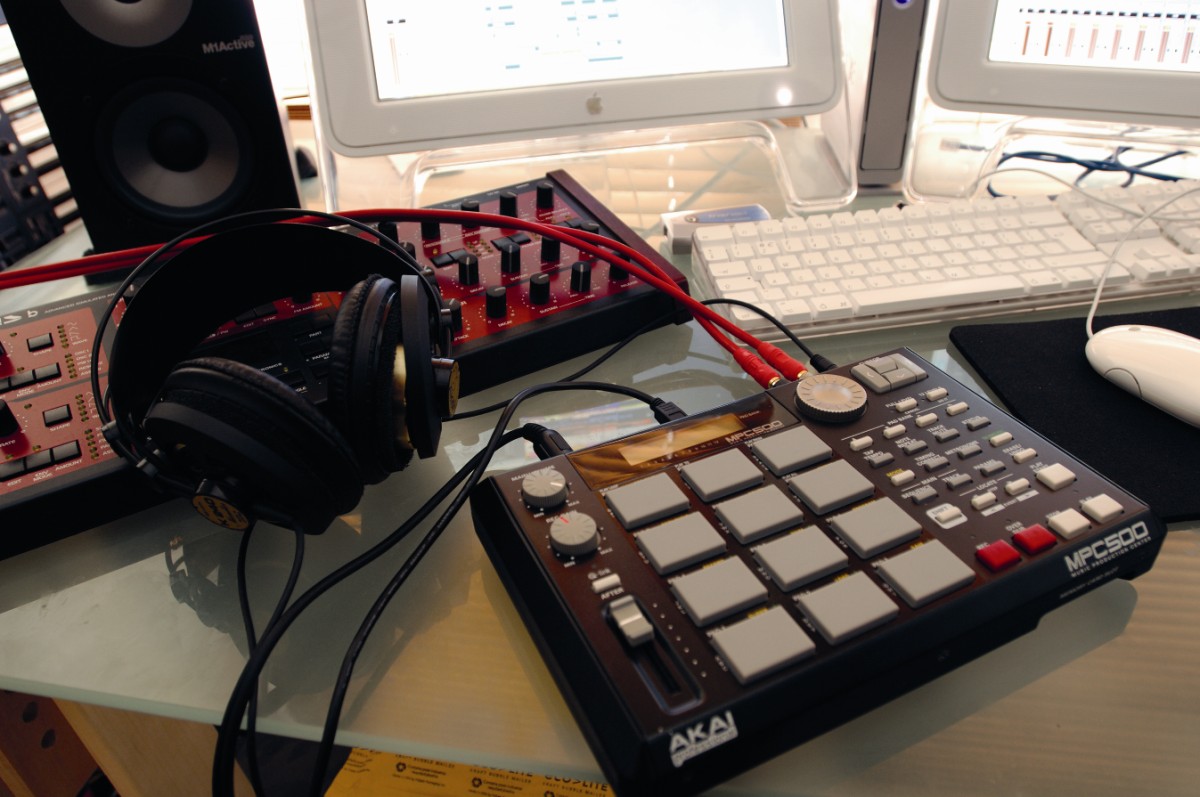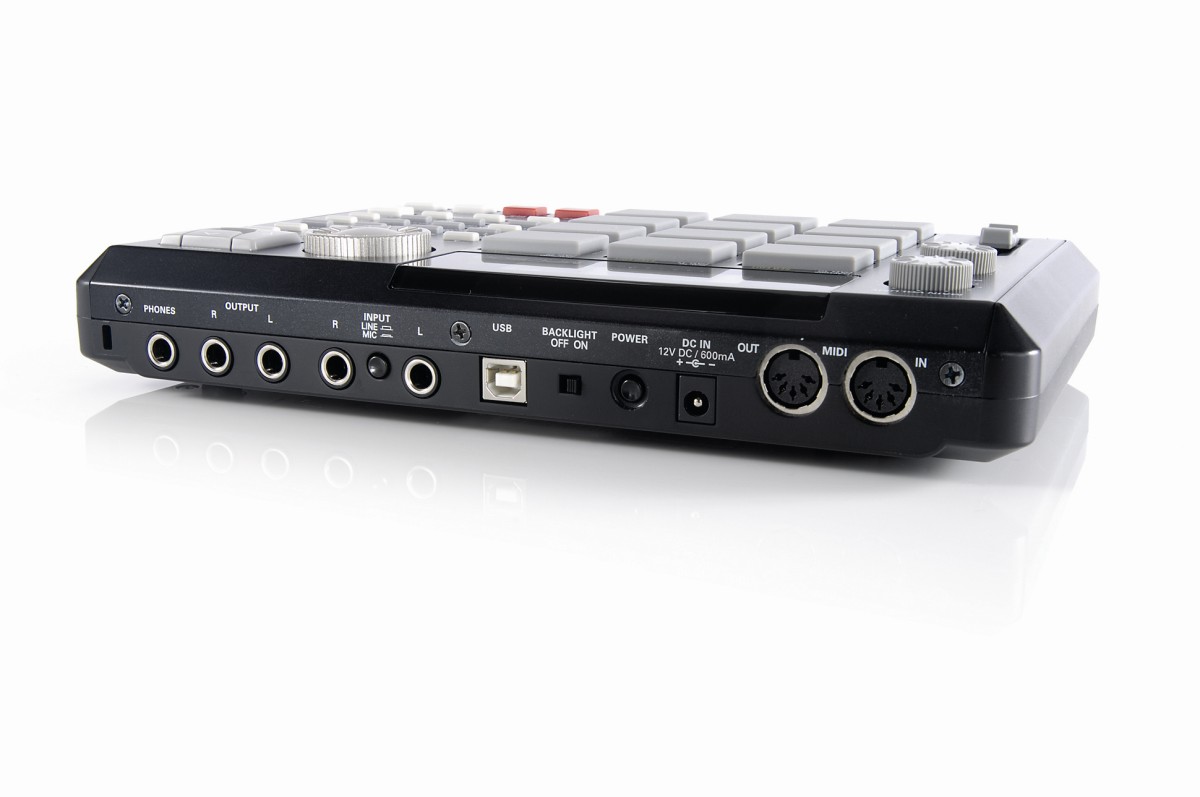MusicRadar Verdict
It might strip back a few MPC features, but it offers true portability in their place.
Pros
- +
Great fun to use, but a really useful tool. Stacked with features. Battery power means true portability.
Cons
- -
Lacking the outputs and facilities of its larger brothers. Only 12 pads rather than the usual 16.
MusicRadar's got your back

Akai MPC500 Music Production Centre

Akai MPC500 Music Production Centre

Akai MPC500 Music Production Centre
Back in 1988, Roger Linn joined forces with Akai to produce the first MPC sampling drum machine. The MPC60 was its name. Such was its success that Akai have been developing variations, updates and modifications of it ever since.
The basic MPC concept is a simple, three-stage affair: firstly, provide sampling as standard, so that a library of individual hits and phrases can be recorded and saved onboard.
Secondly, put pads on the front panel to allow direct, touch-sensitive access to the sample collection.
And lastly, shove in a fully-fledged sequencer that allows the arrangement of these hits into a series of patterns, which can be easily chained together into songs.
The original units were brilliant for a number of reasons; the principal one being that suddenly three big areas of performance were housed under one roof.
But in these days of all-singing, all-dancing DAWs, our needs have changed and functionality of this type isn't just standard, it's been equalled and surpassed by the functions offered by software-based sequencers.
So, what does the MPC have to offer us now? And how does this latest model, the MPC500, Fit into the rest of Akai's range?
Want all the hottest music and gear news, reviews, deals, features and more, direct to your inbox? Sign up here.
The MPC has endured, in part, as not everyone is as taken with the DAW concept as us studio types. The immediacy of the system described above shouldn't be underestimated and neither should its playability.
Also, the early days of DAW development, particularly when MIDI and audio were first housed under one roof, had many of us recoiling from horrible timing clashes between different types of data - none of which troubled the trusty MPC range.
It's easy to find interviews and testimonies from countless producers who continue to swear by their Akai units. For as long as this remains true, the legend will endure. So what does the MPC500, offer?
Hands on
The MPC500 joins the range at the bottom of the ladder at the bottom of the ladder, offering an affordable way to get your hands on the technology.
On the sample front, the 500 offers 16-bit, 44.1kHz sampling with 16MB of memory.
The sequencer offers 100,000 steps, with capacity for 99 sequences. Sequences can be ordered and saved into songs, 20 of which can be held onboard.
The 500 also breaks with the MPC tradition of offering 16 pads, with 12 instead present; the 500 is considerably smaller than its peers, so this is simply a decision designed to save space.
The rest of the top panel features transport controls, a volume control and gain dial for input sources, plus Akai's Q-link controller.
Elsewhere, assorted buttons provide access to the MPC's various modes, which we'll get to very shortly.
Round the back, you'll find line level stereo in and out, MIDI In/Out, USB and headphone ports and a toggle switch to power up the LCD's backlight.
The front panel features a slot for a Compact Flash card, while the underside of the unit reveals a big feature of the MPC500; a battery compartment for six AAs.
Add this feature to the new compact size and it's clear Akai want to push this box as a creative solution for live musicians.
In use
Immediate, fun and intuitive are the three words that spring to mind with this latest MPC.
The 500 ships with four demo tracks which do a good job of showcasing the MPC's sound and playability.
Once one of these songs is selected the sample set spreads itself out over the pads so that the individual samples can be triggered, in true MPC tradition.
As mentioned there are 12 physical pads, but these are organised into four pad banks - a simple button press takes you from one to the next - so 48 actual samples can be triggered from the front panel as a set.
The pads themselves are, of course, velocity sensitive and require a pretty substantial tonk to play really loudly.
These onboard sample sets feature bass sequences, percussion and effects alongside the beats too, there's a reason why Hip Hop and R 'n' B producers have taken these machines to heart.
However, the real joy comes when you start sampling and creating sound sets of your own - this is, after all, why you'd buy this box in the first place.
Once you've connected your recording source at the back, it's easy to set gain control for the inputs and capture a recording.
You can then assign your new sample to a pad and repeat the process to your heart's content, building a library as you go.
Making tracks
Once your samples are safely onboard, it's time to build a sequence.
This can be done in step-time via a MIDI keyboard or, most likely, in real-time via the pads, which is certainly the most fun and hassle free way.
Choose a tempo, select an empty sequence from the 99 available locations, then hit 'record' and 'play start' at the same time.
A one-bar count in will then lead you into a two-bar default loop (this can be extended) during which time you can bash as many pads as you like.
The loop cycles round, playing back the results as you go, so layering multiple overdubs is quick, easy and enormously fun.
If you make a mistake or have second thoughts about a particular sound, a quick hold of 'erase' while tapping the offending pad will remove its contents from your sequence.
Once you've created your sequence you can then build it into a song arrangement, as these organise sequences and decide how long they'll play for before the next one takes over.
If you're working live and don't like the idea of predetermining these changes, lining sequences up and notching the MPC from one to the next is also child's play.
Edits and control
The pads themselves double as function switches, accessing a range of controls. They dial up load and save options, for example, as well as allowing access to the onboard effects and audio edit tools, like Sample Trim and Loop.
The front panel also features a tap-tempo button, which you hold down whilst banging repeatedly on any pad to determine the tempo you want.
This is well designed, as you can't do this inadvertently; good news for wannabe live users.
The Timing Correct feature acts as Quantise for your real-time pad recordings and defaults to 'on', though this can be disabled if you want a looser feel.
As expected, the timing is rock solid. The Q-Link slider on the front panel lets you assign a parameter and perform real-time edits.
Summary
The MPC500 is great fun, but a serious musical tool as well. It's obviously aimed at musicians on the move and nothing rivals it for portability and instant rhythmic gratification.
There's no real learning curve as all functions are either immediately obvious or well described in the manual.
Akai offer a useful comparison chart on their website so that you can check the 500's spec against the other MPC models available.
I guess this is the one area you'll need to do some research into if you're considering a purchase. Do you need extra outputs, digital connections and the like?
Generally, the more advanced features come in bigger, less portable boxes and won't run off batteries, so the choice is yours.
Assuming you can sacrifice these things, we can't recommend the 500 highly enough as a beat maker and phrase sampler. Legend preserved, reputation intact.
Future Music is the number one magazine for today's producers. Packed with technique and technology we'll help you make great new music. All-access artist interviews, in-depth gear reviews, essential production tutorials and much more. Every marvellous monthly edition features reliable reviews of the latest and greatest hardware and software technology and techniques, unparalleled advice, in-depth interviews, sensational free samples and so much more to improve the experience and outcome of your music-making.
